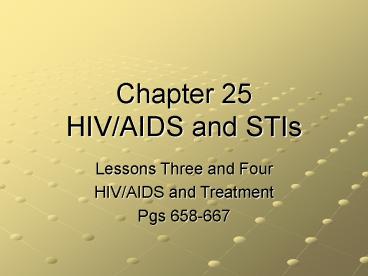Chapter 25 HIV/AIDS and STIs - PowerPoint PPT Presentation
1 / 16
Title:
Chapter 25 HIV/AIDS and STIs
Description:
Chapter 25 HIV/AIDS and STIs Lessons Three and Four HIV/AIDS and Treatment Pgs 658-667 AIDS and HIV AIDS (Acquired Immune Deficiency Syndrome), a disease in which the ... – PowerPoint PPT presentation
Number of Views:205
Avg rating:3.0/5.0
Title: Chapter 25 HIV/AIDS and STIs
1
Chapter 25HIV/AIDS and STIs
- Lessons Three and Four
- HIV/AIDS and Treatment
- Pgs 658-667
2
AIDS and HIV
- AIDS (Acquired Immune Deficiency Syndrome), a
disease in which the immune system is weakened - HIV is the Human Immunodeficiency Virus and it
attacks the immune system - In 2000, AIDS was the fifth leading cause of
death among adults ages 25-44
3
Teens at Risk
- The overall rate of new cases of HIV has fallen
since 1985, but there has been no decline in the
number of youth ages 13 to 24 that are diagnosed - Teens have one of the fastest growing rates of
HIV infection - HIV can be prevented by abstaining from sexual
activity and injecting drugs
4
HIV and the Human Body
- HIV invades cells of the immune system. The virus
takes over the cells and destroys them. - The immune system is less capable of preventing
infections and cancer. The individual will suffer
one illness after another. - HIV does not necessarily mean a person has AIDS.
AIDS is the advanced stage of HIV.
5
HIV and the Human Body
- HIV causes the body to be susceptible to other
infections - Opportunistic infections occur in individuals who
do not have healthy immune systems - Cancer often develops as a result of HIV
- Kaposis lesions
6
How HIV is Transmitted
- HIV lives inside cells and body fluids. It does
not survive well in the air or on surfaces such
as telephones and toilets - It cannot be transmitted through food
- HIV can only be transmitted by an infected person
through blood, semen, vaginal secretions, and
breast milk
7
HIV Transmission
- Sexual contact (intercourse and oral sex)
- Needles for drug use. Contaminated needles can
send HIV directly into the bloodstream. - A pregnant mother with HIV can pass it to her
baby through umbilical cord blood and during
delivery. HIV can also be passed through breast
milk
8
HIV Transmission
- HIV has NOT been shown to be spread through
- Insect bites
- Sweat
- Sneezing
- Casual physical contact like shaking hands and
hugging
9
Stages of HIV
- HIV develops in stages over several years.
- About half of all people with HIV develop
symptoms about 3 to 6 weeks after becoming
infected. - Symptoms include fever, rash, headache, body
aches, and swollen glands. These symptoms will
disappear and are often mistaken as a flu
10
Asymptomatic Stage
- After the flulike symptoms disappear, a person
enters the asymptomatic stage. During this stage
there are no symptoms - The asymptomatic stage can last anywhere from 6
months to 10 years - Even though no symptoms are present, the virus
continues to grow and the person can infect
others.
11
Symptomatic HIV Infection
- The symptomatic stage is marked when infections
start to take over. - Symptoms occur as a result of a severe drop in
immune cells. - The symptoms may include swollen glands, weight
loss, and rashes
12
AIDS
- AIDS is the latter stage of the HIV infection.
The immune system is damaged and there are one or
more opportunistic infections or illnesses. - By the time AIDS develops, HIV has often attacked
brain cells, causing difficulty in thinking and
remembering - These illnesses lead to death
13
Detecting HIVEIA Test
- EIA Test-a blood test that screens for the
presence of antibodies The EIA may give
inaccurate results for two reasons - 1. The test could come back negative in the early
stages because the antibodies have not developed
yet. - 2. Other health conditions can cause a false
positive reading.
14
Detecting HIVWestern Blot Test
- The Western Blot Test is the most common test for
HIV used in the U.S. - If done properly, it is 100 accurate
15
Health Services
- Back in the 1980s there were no treatments for
HIV - Since then, many medications are used to treat
HIV and prevent complications - There is still no cure for HIV/AIDS but treatment
can extend and improve the quality of life
16
Abstinence and HIV/AIDS
- Avoid drug use or the pressure to engage in
sexual activity Leave parties where things get
out of control - Practice refusal skills
- Choose your relationships carefully. Dont date
people who you know are sexually active. Avoid
drug users.































